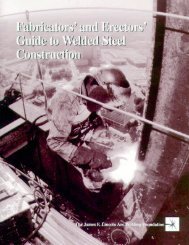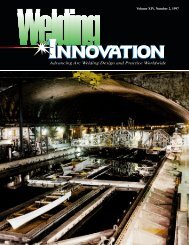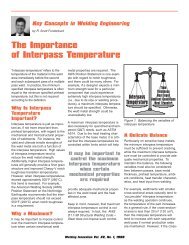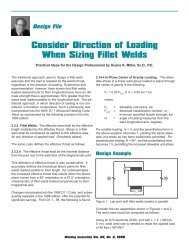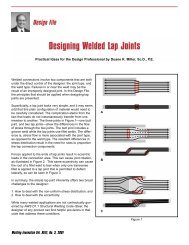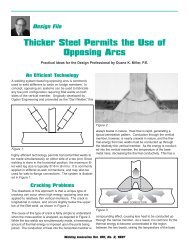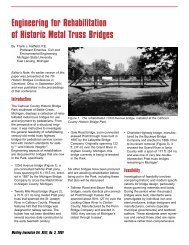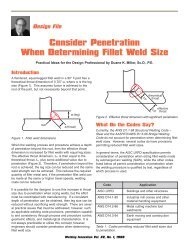The Fall of Skyscrapers
The Fall of Skyscrapers
The Fall of Skyscrapers
Create successful ePaper yourself
Turn your PDF publications into a flip-book with our unique Google optimized e-Paper software.
the World Trade Center towers should<br />
have been viewed as a poor investment<br />
and so might not have been<br />
undertaken as a strictly private enterprise.<br />
In fact, it was the Port <strong>of</strong> New<br />
York Authority, the bi-state governmental<br />
entity now known as the Port<br />
Authority <strong>of</strong> New York and New Jersey,<br />
that in the 1960s undertook to build<br />
the towers. With its ability to issue<br />
bonds, the Port Authority could afford<br />
to undertake a financially risky project<br />
that few corporations would dare.<br />
Sometimes private enterprise does<br />
engage in similarly questionable<br />
investments, balancing the tangible<br />
financial risk with the intangible gain in<br />
publicity, with the hope that it will<br />
translate ultimately into pr<strong>of</strong>it. This was<br />
the case with the Empire State<br />
Building, completed in 1931 and now<br />
the seventh tallest building in the<br />
world. Although it was not heavily<br />
<strong>The</strong> Port Authority could<br />
undertake a financially risky<br />
project that few corporations<br />
would dare<br />
occupied at first, the cachet <strong>of</strong> the<br />
world’s tallest building made it a prestigious<br />
address and added to its realestate<br />
value. <strong>The</strong> Sears Tower stands<br />
an impressive 110 stories tall, the<br />
same count that the World Trade<br />
Center towers once claimed. This skyscraper<br />
gained for its owner the prestige<br />
<strong>of</strong> having its corporate name<br />
associated with the tallest building in<br />
the world. <strong>The</strong> Sears Tower, completed<br />
in 1974, one year after the second<br />
World Trade Center tower was finished,<br />
held that title for more than 20<br />
years-until the twin Petronas Towers<br />
were completed in Kuala Lumpur,<br />
Malaysia, in 1998, emphasizing the<br />
rise <strong>of</strong> the Far East as the location <strong>of</strong><br />
new megastructures.<br />
Building Innovation<br />
It is not only the innovative use <strong>of</strong> elevators,<br />
marketing and political will that<br />
has enabled super-tall buildings to be<br />
built. A great deal <strong>of</strong> the cost <strong>of</strong> such a<br />
structure is in the amount <strong>of</strong> materials<br />
it contains, so lightening the structure<br />
lowers its cost. Innovative uses <strong>of</strong><br />
building materials can also give a skyscraper<br />
more desirable <strong>of</strong>fice space.<br />
Now more than 70 years old, the steel<br />
frame <strong>of</strong> the Empire State Building has<br />
closely spaced columns, which break<br />
up the floor space and limit <strong>of</strong>fice layouts.<br />
In contrast, the World Trade<br />
Center employed a tubular-construction<br />
principle, in which closely spaced<br />
steel columns were located around the<br />
periphery <strong>of</strong> the building. Sixty-footlong<br />
steel trusses spanned between<br />
these columns and the inner structure<br />
<strong>of</strong> the towers, where further columns<br />
were located, along with the elevator<br />
shafts, stairwells and other non-exclusive<br />
<strong>of</strong>fice space. Between the core<br />
and tube proper, the broad columnless<br />
space enabled open, imaginative<br />
and attractive <strong>of</strong>fice layouts.<br />
<strong>The</strong> tubular concept was not totally<br />
new with the World Trade Center, it<br />
having been used in the diagonally<br />
braced and tapered John Hancock<br />
Center, completed in Chicago in 1969.<br />
<strong>The</strong> Sears Tower is also a tubular<br />
structure, but it consists <strong>of</strong> nine 75-<br />
foot(23-meter)-square tubes bundled<br />
together at the lower stories. <strong>The</strong> varying<br />
heights <strong>of</strong> the tubes give the Sears<br />
Tower an ever-changing look, as it presents<br />
a different pr<strong>of</strong>ile when viewed<br />
from the different directions from<br />
which one approaches it when driving<br />
the city’s expressways. When new to<br />
the Manhattan skyline, the unrelieved<br />
209-foot(64-meter)-square plans and<br />
unbroken 1,360-foot(415-meter)-high<br />
pr<strong>of</strong>iles <strong>of</strong> the twin World Trade Center<br />
buildings came in for considerable<br />
architectural criticism for their lack <strong>of</strong><br />
character. Like the Sears Tower, however,<br />
when viewed from different<br />
angles, the buildings, especially as<br />
they played <strong>of</strong>f against each other,<br />
enjoyed a great aesthetic synergy. <strong>The</strong><br />
view <strong>of</strong> the towers from the walkway <strong>of</strong><br />
the Brooklyn Bridge was especially<br />
striking, with the stark twin monoliths<br />
echoing the twin Gothic arches <strong>of</strong> the<br />
bridge’s towers.<br />
Although the World Trade Center towers<br />
did look like little more than tall<br />
prisms from afar, the play <strong>of</strong> the everchanging<br />
sunlight on their aluminumclad<br />
columns made them new<br />
buildings by the minute. From a closer<br />
perspective, the multiplicity <strong>of</strong> unbroken<br />
columns corseting each building<br />
also gave it an architectural texture.<br />
<strong>The</strong> tubular concept<br />
was not totally new<br />
with the WTC<br />
<strong>The</strong> close spacing <strong>of</strong> the columns was<br />
dictated by the desire to make the<br />
structure as nearly a perfect tube as<br />
possible. A true tube, like a straw,<br />
would be unpunctured by peripheral<br />
openings, but since skyscrapers are<br />
inhabited by people, windows are considered<br />
a psychological must. At the<br />
same time, too-large windows in very<br />
tall buildings can give some occupants<br />
an uneasy feeling. <strong>The</strong> compromise<br />
struck in the World Trade Center was<br />
to use tall but narrow windows<br />
between the steel columns. In fact, the<br />
width <strong>of</strong> the window openings was<br />
said to be less than the width <strong>of</strong> a person’s<br />
shoulders, which was intended<br />
by the designers to provide a measure<br />
<strong>of</strong> reassurance to the occupants.<br />
Since the terrorist attack, however,<br />
one <strong>of</strong> the most haunting images <strong>of</strong><br />
those windows is <strong>of</strong> so many people<br />
standing sideways in the openings,<br />
clinging to the columns and, ultimately,<br />
falling, jumping or being carried to<br />
their death.<br />
Welding Innovation Vol. XIX, No. 1, 2002




